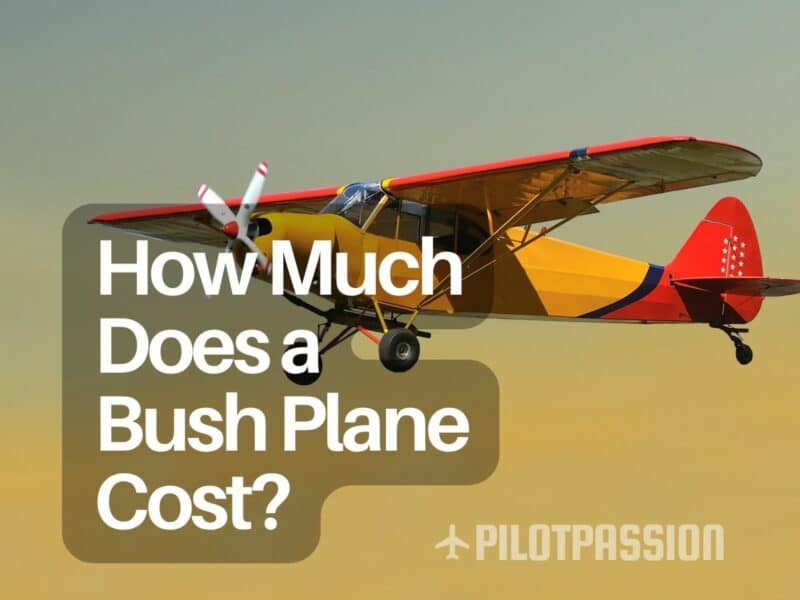In the enigmatic world of bush planes, price tags float as much as the aircraft themselves. Ready to whisk you away? Buckle up for a financial takeoff, with off-the-shelf models setting you back $20,000 to $40,000.
Got a plane and itching for a bush makeover? Prepare to shell out an extra $5,000 to $10,000.
But here’s a pro tip: snag an already modified bird. It’s lighter on the wallet and, if it’s clocked decent airtime, you’ve hit the aviation jackpot.

Table of Contents
How Much Does a Bush Plane Cost? Price Could Vary
The cost of a bush plane will be one of your biggest considerations if you opt to buy one. For all intents and purposes, bush planes are like other aircraft but have been modified for different takeoff and landing conditions.
When you are figuring out the costs, you’ll benefit from starting with the average cost of a plane meeting your needs. Adding the modification cost to this expense will give you a better idea of your costs.
Depending on the plane’s requirements, you might expect modifications to increase the cost from $5,000 to $10,000. When you take these costs into account, your bush plane could range from $20,000 to a price in excess of $50,000.
If you buy a bush plane that’s been in use, you’ll have a better idea of whether it can meet your demands. Used bush planes that are ready for you to use might cost $20,000-$40,000.
What’s the Lowest Price You Can Pay for a New Bush Plane?
Some new bush planes are available for $8,000-$15,000, although some may cost as much as $100,000. Most of these planes are single-engine, involving lower operational and maintenance costs.
If you expect to travel frequently or are unable to rent a bush plane for your needs, purchasing one is a wise choice. A rule of thumb that many pilots rely on is whether your flying equates to 100 hours or more.
What is One of the More Expensive Bush Planes?
The Beaver, made by de Havilland, is the most popular and one of the most expensive bush planes. The average price for a used plane of this model is $350,000.00.
The plane is popular in Alaska and Canada. This aircraft is versatile enough for coastal and lake areas, as well as used in the Arctic.
One of the plane’s most popular features is its capacity to carry large loads. The Beaver is also a short takeoff and landing (STOL) aircraft that does not require a conventional runway.
Are Bush Planes Generally Safe to Fly?
Bush planes have a higher overall safety risk due to factors largely beyond pilot control. These factors include:
- Difficult landing locations
- More rugged terrain
- Inaccurate weather reports
- Rapidly-changing weather
Bush planes land in locations where other planes cannot. However, this increases the risk of accidents, mainly because these locations lack the guidance that pilots receive when landing at conventional airfields.
These planes also take off from and land on more rugged terrain. Taking off or landing in one of these planes is a challenging experience.
Weather reports for locations that bush planes frequently fly to are often unreliable. Reliable weather reports are necessary for a safe flight, especially in challenging areas.
The weather in Alaska and other locations where people frequently fly bush planes can change with little warning. A pilot could find themselves in the middle of an unexpected storm very quickly.
These problematic conditions contribute to the cost of these planes. To withstand these adverse conditions, the aircraft must have features increasing overall durability.
What is a Taildragger?
Bush planes are customarily taildraggers. Planes that have taildragger-style landing gear have two wheels at the front, and one at the back.
The wheel position allows for easier takeoff in a nose-up position, which reduces the risk of propeller strikes. Because these planes frequently land on rougher terrain, these features help maximize aircraft safety, which also contributes to a higher price.
Can Bush Planes Land Anywhere?
Bush planes can technically land on any public location not currently in use. An example of one place where a landing might be considered reckless and subject to prosecution is a road or highway.
Landing off-field is an everyday occurrence for bush planes in many locations. For example, bush pilots in Alaska often land in areas without runways or on water.
Because these planes can land in different types of locations from most other aircraft, they may often have a higher price than conventional planes. Modifications to allow landing on snow or water can also increase the plane’s overall cost.
Final Thoughts
Want to join the bush league? Be prepared to shell out some sky-high bucks.
These rugged flyers don’t come cheap, but with the right mods you’ll be touching down in the most remote locales. Sure, you’ll pay more for the flexibility to land on a lava field or a glacier.
But bouncing through the bush beats a boring runway any day. Just fill ‘er up, buckle in, and you’ll be on cloud nine in the middle of nowhere. The sky’s the limit in a bush plane – if your bank account can handle the turbulence.
Happy off-roading!